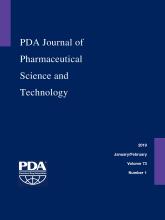Abstract
Tolerance intervals are used to statistically derive the acceptance limits to which drugs must conform upon manufacture (release) and throughout shelf-life. The single measurement per lot in release data and repeated measurements per lot longitudinally for stability data have to be considered in the calculation. Methods for the one-way random effects model by Hoffman and Kringle (HK) for two-sided intervals and Hoffman (H) for one-sided limits are extended to a random-intercept, fixed-slope model in this paper. The performance of HK and H was evaluated via simulation by varying the following factors: (a) magnitude of stability trend over time, (b) sample size, (c) percentage of lot-to-lot contribution to total variation, (d) targeted proportion, and (e) data inclusion. The performance metrics are average width (for two-sided) or average limit (for one-sided) and attained confidence level. HK and H maintained nominal confidence levels as originally developed, but H is too conservative (i.e., achieved confidence level exceeds the nominal level) in some situations. The HK method adapted for an attribute that changes over time performed comparably to the more computationally intensive generalized pivotal quantity and Bayesian posterior predictive methods. Mathematical formulas and example calculations as implemented using R statistical software functions are provided to assist practitioners in implementing the methods. The calculations for the proposed approach can also be easily performed in a spreadsheet given basic regression output from a statistical software package. Microsoft Excel spreadsheets are available from the authors upon request.
LAY ABSTRACT: Tolerance intervals (a measure of what can be expected from the manufacturing process) calculated from attribute measurements of drug product lots are one of the factors considered when establishing acceptance limits to ensure drug product quality. The methods often used to calculate tolerance intervals when there are multiple measurements per lot and the attribute changes over time are either lacking in statistical rigor or statistically rigorous but computationally intensive to implement. The latter type requires simulations that have to be programmed using specialized statistical software, because closed-form mathematical formulas are not available. As a consequence, some quality practitioners and applied statisticians involved in setting acceptance limits may be hindered in using such computationally intensive methods. This paper aims to address this need by proposing an approach that is statistically rigorous yet simple enough to implement using spreadsheets. The approach builds upon previously published works developed for attributes that do not change over time and adapts the cited works for attributes that change over time. The proposed approach is demonstrated to have good statistical properties and compares favorably against the more computationally intensive alternative methods. The paper provides closed-form mathematical formulas, example data, and illustrative calculations as implemented in programmed R functions to facilitate implementation by practitioners. Alternatively, the calculations can be performed without requiring complex programming/simulation using Microsoft Excel spreadsheets that can be requested from the authors.
- Bayesian posterior predictive
- Generalized pivotal quantity
- Random effects model
- Release and shelf-life specification limits
- Tolerance interval
- © PDA, Inc. 2019
PDA members receive access to all articles published in the current year and previous volume year. Institutional subscribers received access to all content. Log in below to receive access to this article if you are either of these.
If you are neither or you are a PDA member trying to access an article outside of your membership license, then you must purchase access to this article (below). If you do not have a username or password for JPST, you will be required to create an account prior to purchasing.
Full issue PDFs are for PDA members only.
Note to pda.org users
The PDA and PDA bookstore websites (www.pda.org and www.pda.org/bookstore) are separate websites from the PDA JPST website. When you first join PDA, your initial UserID and Password are sent to HighWirePress to create your PDA JPST account. Subsequent UserrID and Password changes required at the PDA websites will not pass on to PDA JPST and vice versa. If you forget your PDA JPST UserID and/or Password, you can request help to retrieve UserID and reset Password below.






